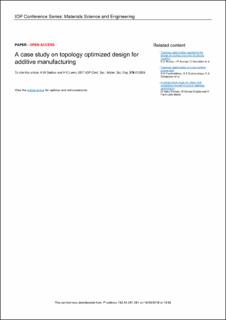| dc.contributor.author | Gebisa, Aboma Wagari | |
| dc.contributor.author | Lemu, Hirpa G. | |
| dc.date.accessioned | 2020-03-20T09:41:47Z | |
| dc.date.available | 2020-03-20T09:41:47Z | |
| dc.date.created | 2017-12-14T14:51:52Z | |
| dc.date.issued | 2017-12 | |
| dc.identifier.citation | Gebisa, A.W., Lemu, H.G. (2017) A Case Study on Topology Optimized Design for Additive Manufacturing. IOP Conference Series: Materials Science and Engineering, 276 | en_US |
| dc.identifier.issn | 1757-8981 | |
| dc.identifier.uri | https://hdl.handle.net/11250/2647738 | |
| dc.description.abstract | Topology optimization is an optimization method that employs mathematical tools to optimize material distribution in a part to be designed. Earlier developments of topology optimization considered conventional manufacturing techniques that have limitations in producing complex geometries. This has hindered the topology optimization efforts not to fully be realized. With the emergence of additive manufacturing (AM) technologies, the technology that builds a part layer upon a layer directly from three dimensional (3D) model data of the part, however, producing complex shape geometry is no longer an issue. Realization of topology optimization through AM provides full design freedom for the design engineers. The article focuses on topologically optimized design approach for additive manufacturing with a case study on lightweight design of jet engine bracket. The study result shows that topology optimization is a powerful design technique to reduce the weight of a product while maintaining the design requirements if additive manufacturing is considered. | en_US |
| dc.language.iso | eng | en_US |
| dc.publisher | IOP Publishing | en_US |
| dc.relation.uri | http://iopscience.iop.org/article/10.1088/1757-899X/276/1/012026/pdf | |
| dc.rights | Navngivelse 4.0 Internasjonal | * |
| dc.rights.uri | http://creativecommons.org/licenses/by/4.0/deed.no | * |
| dc.title | A Case Study on Topology Optimized Design for Additive Manufacturing | en_US |
| dc.type | Journal article | en_US |
| dc.type | Peer reviewed | en_US |
| dc.description.version | publishedVersion | en_US |
| dc.subject.nsi | VDP::Technology: 500::Materials science and engineering: 520 | en_US |
| dc.source.volume | 276 | en_US |
| dc.source.journal | IOP Conference Series: Materials Science and Engineering | en_US |
| dc.source.issue | 1 | en_US |
| dc.identifier.doi | 10.1088/1757-899X/276/1/012026 | |
| dc.identifier.cristin | 1527532 | |
| cristin.unitcode | 217,8,5,0 | |
| cristin.unitname | Institutt for maskin, bygg og materialteknologi | |
| cristin.ispublished | true | |
| cristin.fulltext | original | |
| cristin.qualitycode | 1 | |

